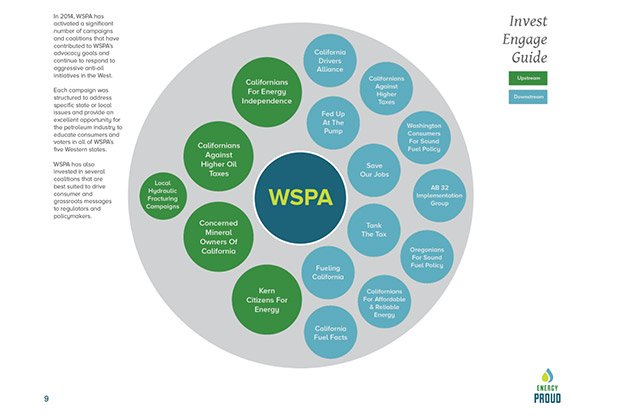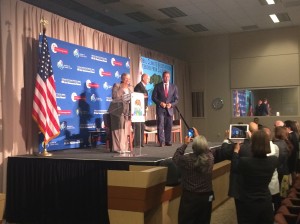Good news on California’s efforts to fight climate change: in-state emissions in 2017 (the latest available data) were down over 2016 and ahead of the state’s mandatory 2020 goals. The California Air Resources Board announced the progress yesterday, with this chart showing emissions in context of population and GDP:
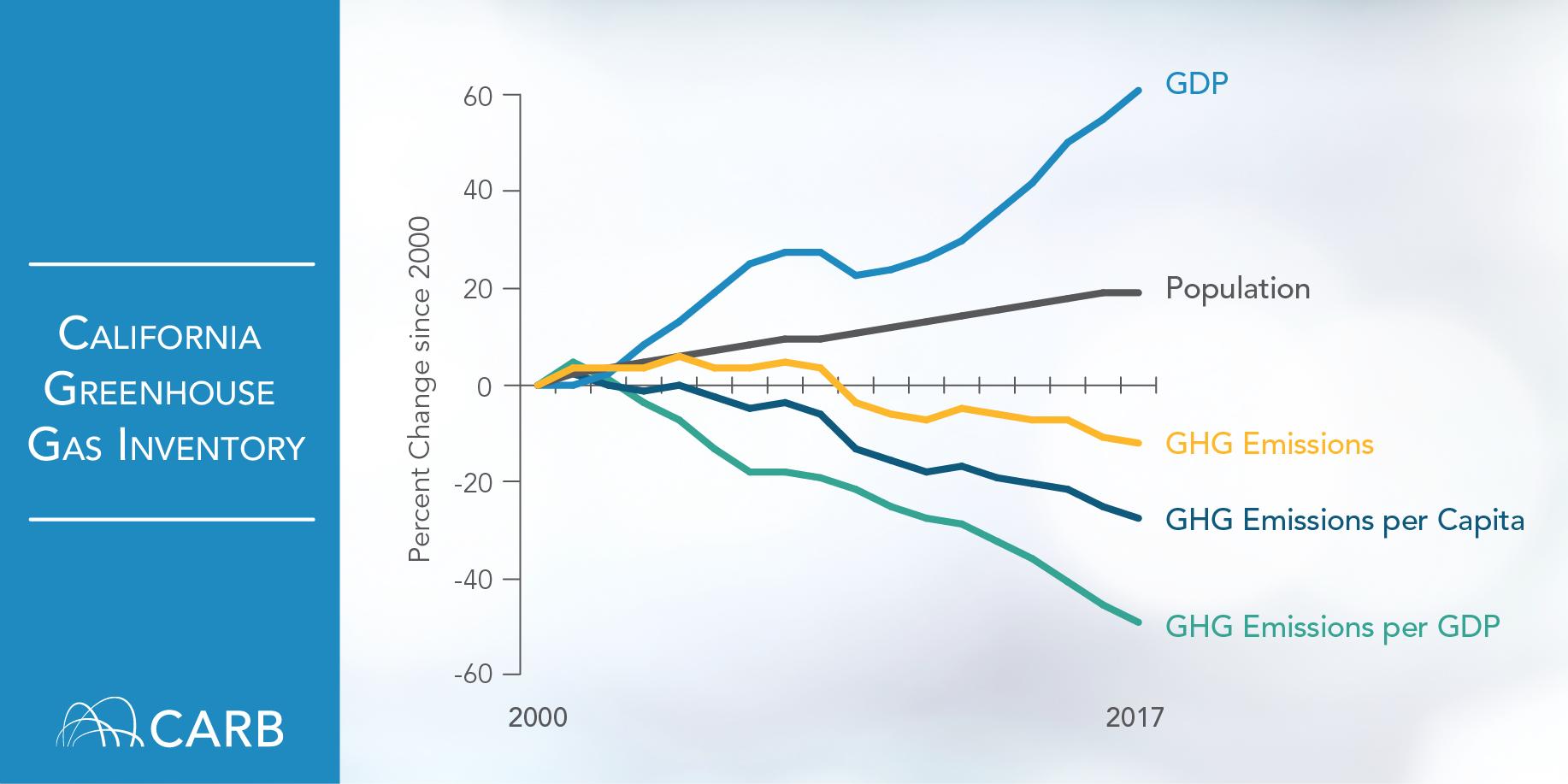
Overall, emissions totaled 424 million metric tons of carbon dioxide equivalent in 2017, down 5 million metric tons from 2016. For reference, the 2020 reduction target is 431 million metric tons.
Most of the progress came from the electricity sector, where for the first time renewable sources made up a larger percentage of the generation than fossil fuels.
However, transportation emissions increased 0.7% in 2017, compared to a 2% increase in 2016, mostly from passenger vehicles. That total is even worse when you consider pollution from oil and gas refineries that make the fuel for these passenger vehicles. Together with hydrogen production, these sources constituted one-third of the state’s total industrial pollution.
Here’s the latest pie chart on where the emissions came from in 2017:
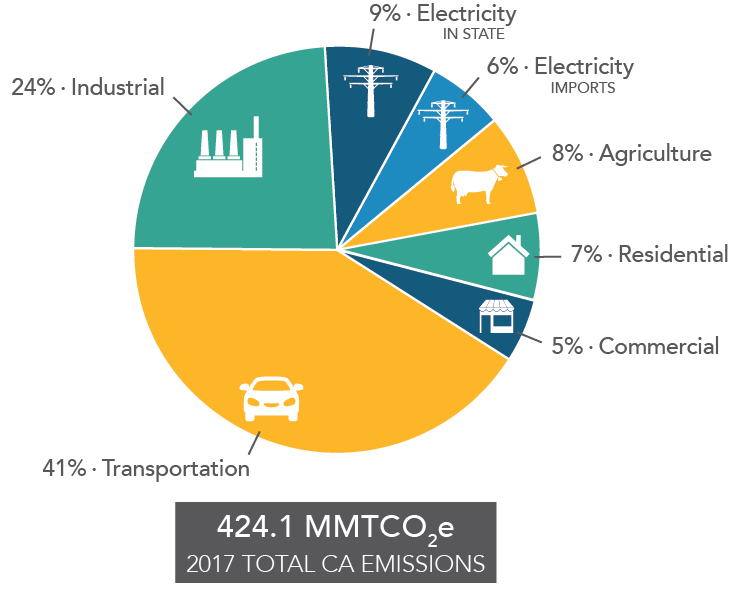
While the story is overall positive for California’s climate efforts, the state will have to redouble its efforts to reduce driving miles by allowing more homes to be built near jobs and transit, while transitioning the remaining driving miles to zero-emission technologies like electric vehicles.
California has already achieved a landmark climate goal, we learned yesterday. Newly released data from 2016 by the California Air Resources Board show that the state’s greenhouse gas emissions decreased 2.7 percent to 429.4 million metric tons.
That number is significant because it’s below the 431 million metric tons the state produced in 1990, which is the level California law requires we achieve once again by 2020. And we’re now four years early on achieving that goal. Since our peak emissions in 2004, California has since dropped those emissions 13 percent.
Much of the reduction is due to significant increases in renewable energy production. Going forward, the next challenge will be a further 40 percent reduction below these 1990 levels by 2030, per SB 32 (Pavley, 2016). And that will require major decreases in emissions from the transportation sector — primarily through greater adoption of zero-emission vehicles.
Importantly, these emission reductions have occurred during a booming economy. The state has effectively de-linked economic growth from carbon-based energy. And all of this economic growth defies industry predictions back in 2006 when the 2020 goal in AB 32 was originally legislated.
As the Sacramento Bee reported at the time during the legislative debates:
[T]he measure [AB 32] is vigorously opposed by the California Chamber of Commerce and the petroleum industry.
”Climate change is real, and we do need to do things,” said Victor Weisser, president of California Council for Environmental and Economic Balance, which represents oil firms. ”But greenhouse gas emissions reduction in California is going to be very expensive.”
In short, industry was not pleased with the climate goals and believed they would cause economic calamity, as another Bee article related:
“We don’t think heavy-handed regulation and bureaucracy is necessary,” said Thomas Tietz, who heads the California Nevada Cement Promotion Council.
Backers say AB 32 would spur new technologies, but Tietz warned that such caps will backfire on the local economy. He said the bill would drive cement producers out of state and force California to import materials produced from countries or states with less stringent environmental rules.
In retrospect, these predictions have not come true. Cement production hasn’t left the state, as industry figures show (although the sector hasn’t fully recovered since the last recession):
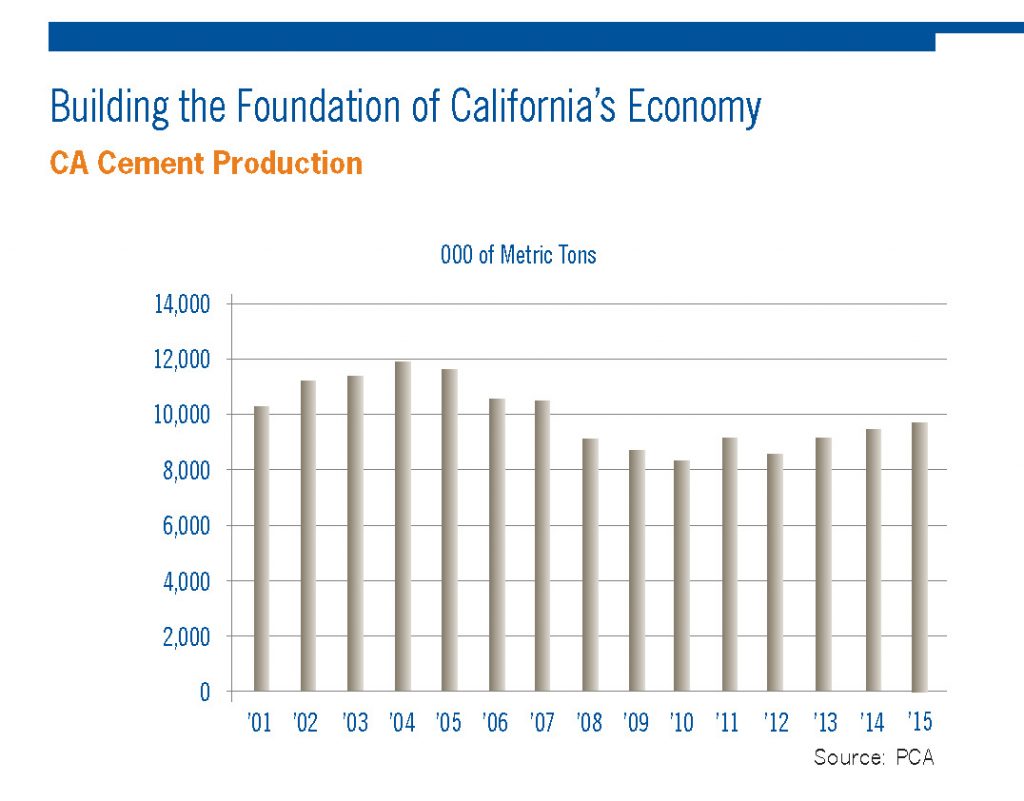 Overall, California’s success is a powerful example for the rest of the world and some important good news in the global fight against climate change.
Overall, California’s success is a powerful example for the rest of the world and some important good news in the global fight against climate change.
With much of the credit due to the proliferation of inexpensive renewable energy, the next challenge will be to ensure similar progress with zero-emission vehicle technology. And given the state’s track record on climate so far, we should be hopeful that similar success is achievable for 2030.
Yesterday was a big day of celebration for climate advocates in California. AB 32 (Nunez), the state’s signature greenhouse gas reduction bill, was signed in 2006 — ten years ago to the day. It requires California to reduce emissions to 1990 levels by 2020.
The day was marked by a celebration at Sacramento’s California Museum, sponsored by the USC Schwarzenegger Institute. The “Governator” spoke, as did current Governor Jerry Brown, CARB chair Mary Nichols, Sen. Fran Pavley, Sen. Kevin De Leon, and former Assembly speaker Fabian Nunez.
You can watch the full video above, but some highlights involved a vigorous defense of California’s economic growth since AB 32 passed. Speakers noted that the state has just surpassed the United Kingdom as the world’s fifth largest economy and that California’s GDP of 4.2% in 2015 was twice the national GDP of 2%. So claims that AB 32 would tank the economy have been largely put to rest.
Still, there’s reason to be cautious about bragging too soon. The full force of our emissions reduction efforts has not been felt on our economy, other than some changes such as with fuels, more renewables, and the beginnings of an electric vehicle market. The 2020-2030 time frame will involve much more dramatic changes to our energy system and economy if we hope to achieve the targets.
It was also entertaining to watch Governor Schwarzenegger when Gov. Brown reminded the audience that the politically controversial Delta tunnels and high speed rail projects were launched on his watch. And Gov. Brown emphasized that we’re playing “Russian roulette” with the physics of extreme weather if we don’t act now.
So while yesterday was a day to celebrate, much work remains to be done. Fortunately, as the political showing yesterday indicates, we have powerful momentum and support to carry out the task.
One of the keys to passing SB 32 (Pavley), the landmark 2030 climate change legislation the legislature approved this year, is that the California economy has thrived since AB 32 (Nunez) passed in 2006. As many climate advocates have noted, despite lowering emissions on a per capita and aggregate level for over a decade, California’s economy is growing at one of the fastest clips in the nation.
All of this economic activity happened despite numerous regulatory and statutory programs to rein in carbon emissions, including cap-and-trade, renewable energy mandates, energy efficiency standards, and the low-carbon fuel standard. And the state is on pace to meet the AB 32 2020 goals, which requires a return to 1990 levels of emissions (about a 15% reduction from business as usual).
In short, this progress has deflated the typical conservative objections to environmental regulations, that they will be economy crushers and job killers. Here’s a summary of the good news, as Debra Kahn reports in ClimateWire (pay-walled):
Meanwhile, California’s economy since 2006 has jumped from the eighth- to the sixth-largest in the world. Yet the amount of greenhouse gas emissions it produces per person, as well as per dollar of gross domestic product, have fallen. Since 2001, state agencies have reported, its carbon emissions per unit of GDP have fallen 28 percent. Last year, the state was home to 68 percent of all clean technology investment nationwide and led in clean-tech patent registrations, as well, according to environmental advocacy group Next 10. And from 2007 to 2015, California outstripped the United States as a whole in job growth and personal income, according to an analysis released in June by Chapman University.
But the celebration shouldn’t get too loud, at least not yet. It’s clear that the state has benefited from some unusual trends that has made it both easier to meet the emissions goals and to grow the economy in a carbon-lite way. First, the economic recession in 2009 put a significant damper on emissions with a slower economy:
“California had a pretty soft economy for many years after its goal was set,” said Severin Borenstein, an economics professor at UC Berkeley and a member of a committee that the California Air Resources Board (ARB) set up in 2012-13 to advise it on the design of its cap-and-trade market. “Although it’s heating up now, we will easily make the 2020 goal, and that will in large part be due to the weak economy for many years.”
Second, the state’s economy has grown in emission-lite industries:
Since 2009, California has lost 1 percent of its manufacturing jobs, compared to 3.7 percent growth in the United States as a whole. During the same period, California’s information services sector grew 10.9 percent, compared to a 1.4 percent decline nationwide, according to Chapman’s June analysis.
We’ve essentially pushed many energy-intensive industries out of state, while benefiting from a boom in services industry like tech, which has made it much easier to meet these carbon-reduction goals.
To be sure, I would also credit the thoughtful, measured approach of many of California’s climate programs and regulations. And of course we have to credit the innovation in the private sector, bringing down the costs of solar PV and batteries and scaling up electric vehicles and low-carbon biofuels, among others.
But as we head into a post-SB 32 world of 40 percent reductions by 2030, the state may not be so lucky with these larger economic trends going forward. It doesn’t mean we should change the approach, but it means we should be honest about what it takes to decarbonize an entire economy and do everything we can to continue bringing down the costs of the technologies that will help us achieve those goals.
Part of the point of AB 32 was to begin the process of “bending the curve” on emissions and clean tech costs. We’re seeing that happen. But to continue on this path through 2030 without costing the economy significantly (and thereby undermining public support), we’ll need further price declines and massive gains in energy efficiency. It’s all doable, but it still remains an open question as to how much and how soon.
Until then, we may need to inject some notes of caution into an otherwise positive picture, so far.
Forget AB 32, now it’s all about SB 32. With the state well on its way to achieving our greenhouse gas reduction goals by 2020, California legislators unveiled yesterday new 2030 goals, with the one letter change in the main bill’s title understating the significance:
On Monday, Democratic lawmakers in the state unveiled a package of four bills that aim to tackle climate change in the state. One of the bills, SB 350, calls for a 50 percent reduction in petroleum use in cars and trucks, a 50 percent increase in energy efficiency in buildings, and a goal of 50 percent of state utilities’ power coming from renewable energy, all by 2030. Current California law requires utilities get 33 percent of their energy from renewable sources, such as wind and solar, by 2050. SB 350’s goals are virtually the same as the ones called for by California Gov. Jerry Brown in his inaugural address in January.
The legislation, if passed (as seems likely given the strong Democratic majorities in both houses), would have significant immediate effects. First, it would help boost the renewables market, which has been stalled of late due to its present trajectory being on course to meet or exceed the 2020 33% goals. With so many projects in the pipeline, utilities have little incentive to keep procuring unless a new target is legislated.
Second, it will help lawsuits like the one against SANDAG in San Diego, with its weak transportation plan that shows emissions increases out to 2050. The lawsuit hinges on the plan (and its environmental review documentation) not complying with the state’s 2050 goals. But those goals are only an executive order from Governor Schwarzenegger. With legislation underfoot, the challenge to the case has a much stronger chance of surviving state supreme court review.
Finally, it will provide more certainty to all the climate change efforts underway, particularly the cap-and-trade program, which would otherwise expire in 2020. With legislation, industry will know what to expect going forward, and revenue for things like affordable housing near transit, energy efficiency upgrades, and high speed rail, will be dependable for years to come.
Let’s hope the legislation can face a clear path to adoption, without getting watered down by special interest giveaways.
Whoopsie. The Western States Petroleum Association accidentally let slip its strategy document detailing how the oil and gas lobbying front seeks to undermine clean energy laws, especially California’s effort to reduce greenhouse gas emissions by 2020:
Specifically, the deck from a presentation by WSPA President Catherine Reheis-Boyd lays out the construction of what environmentalists contend is an elaborate “astroturf campaign.” Groups with names such as Oregon Climate Change Campaign, Washington Consumers for Sound Fuel Policy, and AB 32 Implementation Group are made to look and sound like grassroots citizen-activists while promoting oil industry priorities and actually working against the implementation of AB 32.
It’s a similar strategy pursued by chemical interests, when they set up a fake firefighter group to keep in place California’s counter-productive flame retardant regulation, which retarded no flames while poisoning kids and firefighters alike when buildings burned.
It’s nice to see this approach exposed for everyone to see. The front groups have thankfully so far failed to motivate the public, but advocates should be wary of this tactic. In the right political climate, it could make a big difference in undermining public support for vital environmental laws. Here’s a hard-to-read chart from the slide deck of all the fake groups they fund (hard to read because they fund so many phony groups):
This morning in Sacramento, former California Governor Arnold Schwarzenegger journeyed back to his old stomping ground to highlight the state’s successes fighting climate change. He joined current governor Jerry Brown and a host of climate experts and business leaders to make the case for the 2015 Paris climate talks that California’s example can be replicated at an international scale.
But for all the dignitaries, politicians, and experts, there was actually very little said about the specific policies that seem to work in California. Nor was there discussion of any of the clean tech businesses that are leading the way to reduce greenhouse gases. Instead, it was a largely symbolic, self-congratulatory event, sprinkled with some useful facts and motivational talks.
First up, the former governator ran through the history of California’s climate fight since he took office, talking about how big business fought the climate agenda at every turn, claiming doom and gloom and seeking to overturn AB 32, the climate law, with a 2010 ballot initiative. “But Californians terminated it” at the polls, he quipped, “saying ‘hasta la vista baby’ to the oil companies.’ Later, Governor Brown echoed this sentiment about big businesses always crying wolf about environmental regulations, noting that Henry Ford himself even came to California to lobby against fuel efficiency standards in the 1970s.
Climate scientists followed, including UC Berkeley’s Dam Kammen and the Pacific Institute’s Peter Gleick. Gleick brought home the impacts of climate change on California when he noted that $100 billion worth of 2000-era buildings are threatened by sea level rise, which could displace 480,000 people living on the coastline and jeopardizing 10,000 megawatts worth of power plants, among other calamities.
A business panel followed, although not one with any of the leading clean technology companies. Former EPA head and now Apple Computers Executive Lisa Jackson described the “fun” and “opportunities” of fighting climate change at Apple with their net-zero data centers. Michael Britt of UPS acknowledged that the company is not afraid of higher gas prices under AB 32 and described internal combustion engines as an unsustainable “bridge” to cleaner technologies. The company will deploy 17 fuel cell trucks in the coming months at one-third the maintenance costs of traditional engines.
State Senate President-to-be Kevin De Leon then joined a panel where he discussed his efforts to include low-income Californians in the fight against climate change. His one million constituents live in a district criss-crossed by seven major freeways, and with 40% of the goods in the United States shipped through there, “a little girl’s lungs subsidize” the cheap purchases we make. Moderator Terry Tamminen noted that kids near the port in Los Angeles/Long Beach lose one percent of their lung capacity on average each year. De Leon felt that government should encourage more private investment in clean technologies, because “there isn’t enough public money” to do the job. He specifically cited the need for a stronger state infrastructure bank, one of the few specific policy needs discussed today.
Finally the current governor spoke, bringing laughs when he said that California’s environmental fight began with a Republican actor turned governor — Ronald Reagan of course, not Schwarzenegger. Brown’s point was that under Reagan and President Nixon, California secured a waiver in the federal Clean Air Act to go beyond federal standards, paving the way for California’s continued leadership on environmental issues. Ultimately, Brown described how we need to look to scientists and entrepreneurs to save us, while government can provide them the incentives.
Missing in the discussion today was exactly that: the businesses and the incentives. For example, no mention of Tesla, the California-bred company that is probably doing the most right now to bring down the costs of the technologies needed to clean our economy. And only a brief mention of the solar rooftop incentives in California and cap-and-trade, with nothing about California’s landmark energy storage law.
If California is going to make a case to the world about the policies needed to reduce carbon, we’ll need to do a better job than what our leaders did today. We can certainly brag about the broad goals California has set, and we should do so. But unless we can demonstrate the specific business and health advantages that the California program has brought, it will all seem pie-and-the-sky to outsiders.

